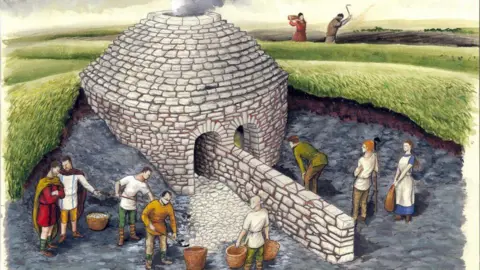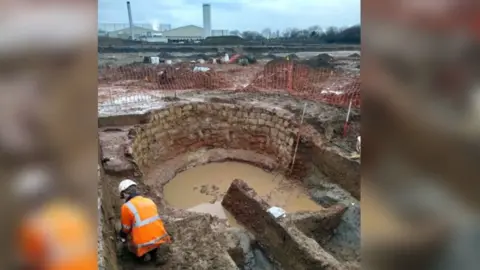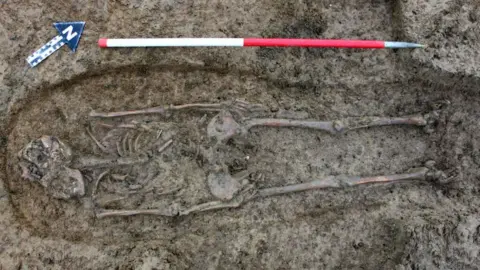Roman lime kiln, grave and buildings found in dig
 Nathan Chinchen
Nathan ChinchenArchaeologists say an "exceptionally well preserved" artefact may be the first to be found in a former Roman settlement.
Cotswold Archaeology unearthed a lime kiln during work on the Centre Severn site near Tenpin in Barnwood, Gloucester, known to the Romans as Glevum, between September 2020 and February 2021.
The structure, measuring 4m (13ft) across and 2m (6.5ft) high, would have been covered in earth and turf and used to make quicklime, a key ingredient in building materials such as mortar and cement.
Archaeologists also discovered two Roman buildings, and the grave of a woman in her 40s, radiocarbon dated to AD 226-336 which is during the time of Roman Britain.
The lime kiln, made of stone blocks set in clay, is thought to be the first excavated in Gloucestershire.
Cotswold Archaeology believes it had a relatively short working life having either collapsed naturally or been dismantled.
Earlier surveys at the Centre Severn site suggested extensive Roman remains may lie underground.
Later Roman activity cut a ditch through its north-eastern side, further confirming that it was abandoned by the 3rd Century.
 Cotswold Archaeology
Cotswold ArchaeologyPaolo Guarino, post excavation assistant manager at Cotswold Archaeology, said it was a significant find.
"The kiln itself is quite rare in Gloucestershire.
"As far as I know, this is the only one that has been fully excavated in the county.
"Roman kilns are well-known but not that widespread."
Mr Guarino said the kiln may have been part of a larger settlement.
The findings from the excavation have allowed the group to build a better picture of how the past landscape may have looked.
"We are able to tell a bit more detail every time we get our hands on it," he added.
 Cotswold Archaeology
Cotswold ArchaeologyFollow BBC Gloucestershire on Facebook, X and Instagram. Send your story ideas to us on email or via WhatsApp on 0800 313 4630.
